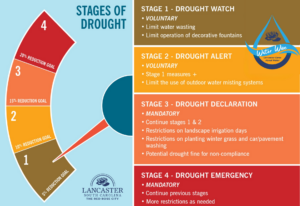Catawba-Wateree Drought Management Advisory Group Stage 1 Drought announcement

Dry weather conditions place Catawba-Wateree River Basin in Stage 1 drought
- Residents encouraged to conserve water
- Duke Energy makes operational adjustments at its hydroelectric facilities
- Duke Energy will monitor lake levels at boat ramps and close boat ramps when needed to ensure public safety
The Catawba-Wateree Drought Management Advisory Group (CW-DMAG) announced on Nov. 1, that warm and dry weather conditions have placed the Catawba-Wateree River Basin in Stage 1 of the group’s Low Inflow Protocol (LIP). Stage 1 is a drought stage that requires the first phase of operational adjustments at Duke Energy’s hydroelectric facilities. Voluntary water conservation by all water users is strongly encouraged.
“While some areas of the basin have received scattered rainfall, the lack of widespread and consistent precipitation along with warm temperatures have resulted in increased drought conditions,” said Ed Bruce, P.E., Duke Energy, CW-DMAG coordinator. “We will continue to monitor conditions and provide updates as needed to best protect the shared water supply available to our communities.”
Due to warm temperatures and below average rainfall since earlier this year, water storage in the 1 reservoirs in the Catawba-Wateree River Basin has decreased and stream flows that feed the reservoirs are well below normal.
“We wanted to be proactive in making the community aware of increased drought conditions and ask customers to be mindful of water use,” explained Jimmy Bagley, City of Rock Hill’s Deputy City Manager and Chair of the Catawba-Wateree Water Management Group. “The sooner we start conserving, the better for our region as we work together to preserve our shared water resources.”
The LIP is the drought management protocol major users of the water from the Catawba- Wateree River Basin use to share responsibility and set priorities to conserve the limited water supply during drought conditions. Stage 1 is the second of five drought stages outlined in the protocol and it requests voluntary water conservation by water users across the basin. Residents using water from a Duke Energy lake for landscape irrigation are asked to limit watering to Tuesdays and Saturdays.
During drought conditions, Duke Energy’s hydroelectric plants continue to operate but at reduced levels to progressively decrease downstream flows and preserve water storage in the lakes.
At Stage 1, hydroelectric operational adjustments include:
- A reduction in downstream minimum flow releases.
- Reduced recreational flow hours
- Adjustments to the allowed minimum lake water levels.
At Stage 1, Duke Energy will increase surveillance of its public boating access areas along the lakes. To ensure the safety of boaters and protect property, some boat ramps will close temporarily due to declining lake levels. Any closures will be listed on the Duke Energy Lakeview app and Duke-Energy.com/Lakes
CW-DMAG was established in 2006 to monitor drought status and to recommend coordinated actions for CW-DMAG members. CW-DMAG members include the area’s public water suppliers and several large industrial users withdrawing water from the river and lake system, North Carolina and South Carolina resource agencies, other federal agencies and Duke Energy.
CW-DMAG and the LIP resulted from Duke Energy’s relicensing process for the Catawba- Wateree Hydroelectric Project. The LIP is part of Duke Energy’s federal operating license issued by the Federal Energy Regulatory Commission (FERC). CW-DMAG meets at least monthly when conditions reach Stage 0 or greater of the LIP. For more information about CW-DMAG and the LIP, visit duke-energy.com/community/lakes/drought-management-advisory/catawba-wateree-
If community members have specific questions about voluntary water use restrictions, they are encouraged to contact their local water supplier.
Division 5 Chapter 5 under the City of Lancaster Code states,
“The city understands the fundamental need to make efficient use of the limited and valuable water resource under its stewardship to protect the public’s health and safety and environmental integrity. The purpose of this document is to establish a plan and procedures for managing water demand and evaluating supply options before and during a drought-related water shortage. The intent is to satisfy the requirements of the Drought Response Act of 2000 (S.C. Code 1976, § 49-23-10 et seq., as amended) with the goal of achieving the greatest public benefit from domestic water use, sanitation, and fire protection and to provide water for other purposes in an equitable manner. Therefore, the city has adopted this drought management and drought response plan that provide the policies and the authority to fulfill this obligation. The drought management plan outlines the framework by which the city will internally prepare for water shortages. The response plan provides the regulations by which the city will manage and control its customer water usage during various levels of a drought. The city reserves the right to modify the requirements established within each stage of this Drought Management Plan based on the current water supply situation.” Response to Drought Conditions under city code can be found at https://library.municode.com/sc/lancaster/codes/code_of_ordinances?nodeId=COOR_CH40UT_ARTIIWASEGE_DIV5REDRCO
